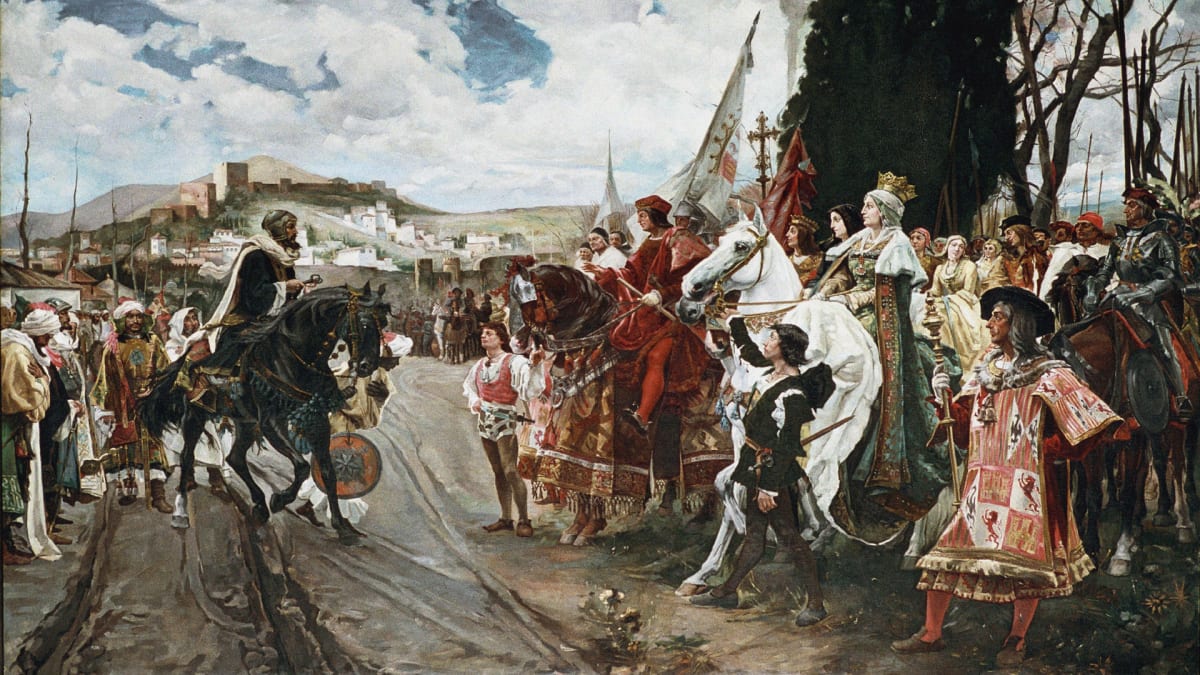The decisive event in the early medieval history of the Iberian peninsula was the conquest by the Muslims, who brought almost the whole of the peninsula under their control. In the eighth and ninth centuries, Christian communities free of Muslim domination survived only in the extreme north.
Starting in the ninth century, these Christian states had pressed southward until the last Muslim stronghold at Granada fell in 1492. The reconquest of Spain, like the great Crusades to the Holy Land, was a disjointed movement, undertaken in fits and starts by rival states that sometimes put more energy into combating each other than into fighting the Muslims.
Three Christian kingdoms dominated the Iberian peninsula in the middle of the fifteenth century. Castile, the largest and most populous, had assumed the leadership of the reconquest. But the power of the Castilian kings did not grow in proportion to their territory. The powerful organization of sheep-ranchers, the Mesta, controlled vast stretches of Castilian territory. Both the nobility and the towns maintained many rights against royal authority. Both were represented, together with the clergy, in the Cortes, the Castilian counterpart of the English Parliament and the French Estates General. The Cortes was, however, largely powerless by the fifteenth century.
To the west of Castile, along the Atlantic coast, lay the second Christian kingdom, Portugal, a former Castilian province that had won independence in the twelfth century. Though still retaining close links with Castile, the Portuguese had developed their own distinctive language and pursued their own national interests, especially in exploration and overseas commerce.
The third kingdom, located in northeastern Spain, was Aragon, which was as much a Mediterranean power as an Iberian one. Its kings controlled the Balearic Islands, ruled lands along the Mediterranean on the French side of the Pyrenees, and had an important stake in southern Italy. In the breakup of the Hohenstaufen Empire, Aragon took the island of Sicily (1282) and King Alfonso V, the Magnanimous (r. 1416-1458), added Naples in 1435. In Aragon, as in Castile, the oldest established political institutions were those limiting the Crown—the nobility, the towns, and the Cortes, which was much more powerful than in Castile. Moreover, two territories of the Crown of Aragon on the Spanish mainland, Valencia and Catalonia, the latter centered on the prosperous port of Barcelona, had Cortes of their own and were, in effect, separate states.
In 1469 Ferdinand, later king of Aragon (1479– 1516), married Isabella, later queen of Castile (1474– 1504), and thus made the dynastic alliance that eventually unified Spain. The obstacles confronting them were enormous. Not only was the royal power weak in both states, the inhabitants of Castile and Aragon did not speak the same language. Aragon looked toward the Mediterranean, Castile toward the Atlantic, so that a union of Castile with Portugal might have been more natural.
Ferdinand and Isabella made a good political partnership. He was a cautious realist and skeptical and tolerant in religion. Isabella, on the other hand, was devout to the point of fanaticism, adored the pomp and circumstance of the throne. She vested much authority in a new body staffed by royal appointees, the Council of Castile. She allied herself with the middle class of the towns against the nobles and drew military support from town militias rather than from feudal levies. Finding her sovereignty weakened by three large military brotherhoods founded in the twelfth century to advance the reconquest (and controlled by the Castilian nobility), she insisted that Ferdinand become head of each brotherhood.
Though pious, the queen was determined to bring the church under royal discipline, and she prescribed a much-needed purge of ecclesiastical corruption. The Spanish monarchs also obtained from the papacy the right to appoint Spanish bishops. Like the Gallican church of France, the Spanish church was half-independent of Rome. The ranking Spanish prelate, Cardinal Jimenez de Cisneros (1436-1517), became Isabella’s chief minister and executed her policies of purifying the church, curbing the aristocracy, and courting the towns.
The Inquisition was introduced into Spain in 1478; it was from the first a royal rather than a papal instrument. The Spanish Inquisition sought to promote Spanish nationalism by enforcing universal Catholicism and to create loyal subjects of the Crown by obliging all people to be obedient children of the church. Its chief targets New Christians, or Marranos—Jews secretly practicing their old faith. The persecution was so menacing, with its tortures and burnings at the stake, that more than 100,000 New Christians fled the country,.
In 1492 unconverted Jews were confronted with the alternatives of baptism or exile with the loss of their property; about 150,000 chose exile. Ten years later, it was the turn of the Muslims, who received no choice except baptism. Catholicism thereby won many nominal new adherents who conformed only because they dreaded what the Inquisition had in store for those who wavered in their new faith.
The year 1492, accordingly, may be viewed as the most crucial date in Spanish history. It began, on January 2, with the triumphal entry of Ferdinand and Isabella into Granada, marking the conquest of the last fragment of independent Muslim Spain. Later in the year, the way was opened for immense new conquests when Christopher Columbus sailed from a Castilian port on the first of his voyages to the New World.

